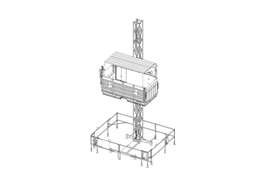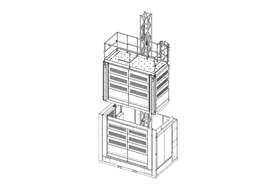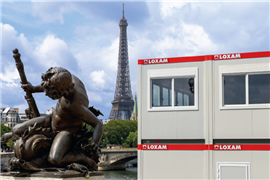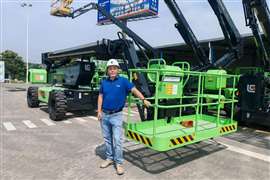IPAF warns against misuse of transport platforms
28 agosto 2025
The International Powered Access Federation (IPAF) has issued a warning about the misuse of transport platforms outside of EN standards and promised further action if standards are not met by the industry.
In a statement IPAF said it had come to its attention that certain construction hoist manufacturers are marketing equipment, described as transport systems or other similar terminology, that look like transport platforms, but with operating speeds and passenger capacities that exceed the limits set for a transport platform in the European EN 16719 standard.
 Transport Platform – EN 16719. (Image: IPAF).
Transport Platform – EN 16719. (Image: IPAF).
IPAF points out that the EN 16719 standard specifies safety requirements for transport platforms used for the vertical transportation of goods and passengers on construction sites under defined limits such as a maximum speed of 0.2 m/s and a maximum of seven persons, ensuring safe use under these conditions.
In contrast, says IPAF, the EN 12159 applying to construction hoists is designed to carry passengers and materials, which can operate at higher speeds and greater personnel capacities, because they have stringent safety features, including fully enclosed cabins and automatic landing systems.
“Each standard ensures equipment is used appropriately according to its intended purpose and risk profile,” said IPAF in its statement.
“Suppliers of the aforementioned machines, which do not comply with the EN 16719 standard for transport platforms (such as speed or personnel restrictions) or the EN 12159 standard for passenger hoists (such as requisite safety features), claim that these products have been ‘approved’ and certified by a Third Party.”
Industry implications
IPAF said it considers this to be a dangerous and unacceptable practice and all relevant stakeholders should adhere to the following.
Safety is being compromisedThis practice puts users at significant risk. EN 16719 for Transport Platforms and EN 12159 for Passenger Hoists were developed precisely to define safe operating parameters for such equipment. Any machine operating outside the provisions of these standards, particularly in terms of speed and capacity, falls outside what is considered safe practice. The deliberate deviation of these standards does not eliminate risk, it increases it.
Legal implications Presenting such equipment as outside the scope of current standards using a Third-party certificate does not shield manufacturers, suppliers, rental companies, and duty holders from potential legal consequences. In the event of an accident, the use of a machine not compliant with established European standards could lead to serious legal liability, including criminal prosecution, civil claims, or invalidation of insurance coverage.
 Passenger Hoist – EN 12159. (Image: IPAF).
Passenger Hoist – EN 12159. (Image: IPAF).
Damage to the reputation of the industryThe improper use and classification of lifting equipment can have serious repercussions for the reputation of the entire construction hoist industry. One serious incident resulting from this type of practice could undermine decades of work to promote safety, responsibility, and professionalism across the sector.
“IPAF urges all members of the industry (manufacturers, rental companies, and contractors) to respect and comply with the applicable standards for lifting equipment. We call on all stakeholders to reject ambiguous or misleading classifications of equipment, and to use transport platforms in accordance with the speed and capacity conditions established by European standards,” said the Federation.
Further action
IPAF added, “Should such practices persist, IPAF will be left with no alternative but to pursue formal measures to ensure compliance with the applicable standards. This may include reporting specific cases of non-compliance to the relevant national safety authorities in the countries where misuse of transport platforms outside the scope of EN standards is identified.”
STAY CONNECTED



Receive the information you need when you need it through our world-leading magazines, newsletters and daily briefings.
CONTATTA IL TEAM













